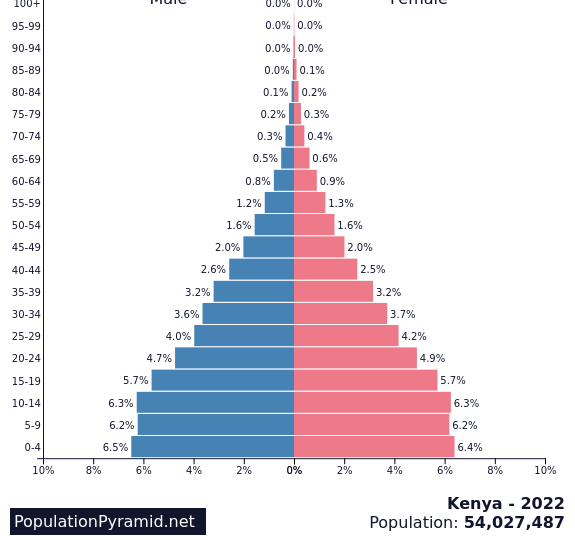When you scroll through news headlines or flip through local debates, you’ll almost always find discussions about Kenya’s rising debt, rampant corruption, or political divisions. And while those are certainly urgent issues, there’s an even bigger problem quietly growing in the background—largely unspoken, rarely debated, but dangerously underestimated: our population demographics.
This is not just a numbers issue. This is a human issue. It’s a crisis about opportunity, stability, and survival. Kenya’s demographic structure is the elephant in the room, and unless we start talking about it, planning for it, and acting on it, we will soon find ourselves overwhelmed by a storm we could have forecasted years in advance.
Let’s look at the numbers—and then let’s talk about what they actually mean.
The Youthful Nation: A Snapshot of Kenya’s Population
As of the end of 2022, Kenya’s population was estimated at 54,027,487. The gender balance is almost perfectly even—49.95% male and 50.05% female. But it’s the age distribution that truly demands our attention:
- Only 4.4% of the population (2.3 million people) is over 60 years old.
- Just 1.6% (around 864,000 people) are over the age of 70.
- An overwhelming 49.3%—that’s nearly half the population—are below the age of 20.
- 58.9% are younger than 25.
- 67.1% are under 30.
- 74.4% are under the age of 35.
- Just 21.2% fall into the age range of 35 to 60 years.
That means more than three-quarters of our population is below the age of 35. Pause for a moment and let that sink in.
Why This Matters More Than You Think
You might wonder: “Isn’t a youthful population a good thing?” In theory, yes. A young population can be a national asset—a sign of potential, energy, innovation, and resilience. This is what economists refer to as a demographic dividend—a golden window where the working-age population is large, productive, and less burdened by dependents (the young and the elderly).
But here’s the catch: A demographic dividend doesn’t happen automatically. It only appears when young people are meaningfully employed, healthy, skilled, and empowered to contribute to the economy. Without that, a youthful population becomes a ticking time bomb.
In Kenya, we are dangerously close to the latter.
The Silent Crisis Brewing
What do you get when you combine a huge youth population with:
- High youth unemployment and underemployment?
- An overstretched education system?
- A lack of technical and vocational training?
- Crumbling public infrastructure?
- Rising mental health challenges and social disillusionment?
You get frustration. Restlessness. Crime. Radicalization. Mass migration. A loss of national potential. And possibly, political instability.
We’ve already seen glimpses of this. The thousands of university graduates roaming the streets without jobs. The disillusioned youth joining protests not just for political reasons, but because of the hopelessness they carry. The increasing numbers of young Kenyans lining up to leave the country through any means necessary, searching for greener pastures in Gulf nations, Europe, or the Americas.
We are watching a generation slip away before our eyes.
What This Means for National Development
Think about how this demographic structure affects development planning.
If more than 67% of your population is under 30, development strategies must prioritize youth empowerment, not as a social good—but as an economic and national security imperative.
We cannot afford to build policies based on outdated assumptions. Our schools, health systems, employment programs, and national budgets must reflect the urgency of this youthful population. Planning for roads and dams without planning for youth employment is like building a house without a foundation.
If we fail to harness this youth power, our economic growth will slow, our social fabric will fray, and our democracy will weaken.
The Cost of Ignoring the Demographic Elephant
There are three main pillars that drive any economy:
- Capital Allocation
- Energy Availability and Consumption
- Population Age Demographics
Kenya has begun addressing capital and energy—though slowly and not without controversy. But on the third, we are worryingly silent.
Ignoring our demographics means:
- We are not building enough quality institutions for the future workforce.
- We are not preparing for the healthcare needs of a youthful, growing population.
- We are not training youth in the skills of the future—digital literacy, green energy, tech, robotics.
- We are not building inclusive economic systems that allow the young to lead.
Worse still, we’re normalizing the idea that young people should “wait their turn,” that experience alone should drive leadership, and that youth participation in national discourse is a bonus rather than a necessity.
What Must Be Done
To turn this looming crisis into an opportunity, Kenya needs urgent, bold action. Here’s what must happen:
1. National Demographic Planning
Every major ministry should have a demographic lens. Whether it’s infrastructure, education, agriculture, or health—youth data should shape the budget.
2. Youth Employment as a National Emergency
Job creation for young people must be treated with the same urgency we give to debt repayment or anti-corruption. This includes investments in green jobs, digital work, gig economies, and MSMEs.
3. Vocational Training and Education Reform
Not every young person will go to university. And not every job requires a degree. We must upscale vocational and technical training that is relevant, modern, and entrepreneurial.
4. Civic and Political Inclusion
Let’s not just talk about youth—let’s talk with them. Youth representation in parliament, county leadership, and policy boards should not be symbolic. It should be strategic.
5. Invest in Health and Mental Wellness
A healthy youth is a productive youth. That includes addressing mental health, sexual and reproductive health, and nutrition.
Conclusion: A Future We Must Earn
Kenya’s youthful population is not just a statistic. Behind every percentage is a face, a dream, a talent waiting to be unleashed. But that dream is fast becoming deferred, and when dreams are deferred for too long, they explode.
This demographic reality is bigger than our debt. Bigger than corruption. Because if we lose this generation, no amount of foreign loans or anti-graft measures will save us.
Let’s wake up to the truth. The real elephant in the room is not just sitting there—it’s growing, restless, and demanding attention. If we listen and act, we can shape a vibrant, prosperous Kenya. If we ignore it, the consequences will shape us instead.
The time to act is now. The youth are not just the future—they are the present. And they’re watching.

